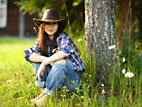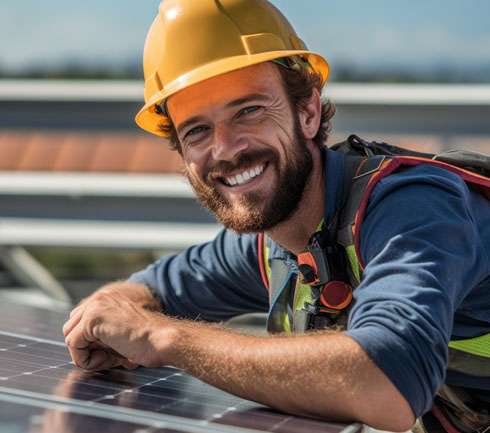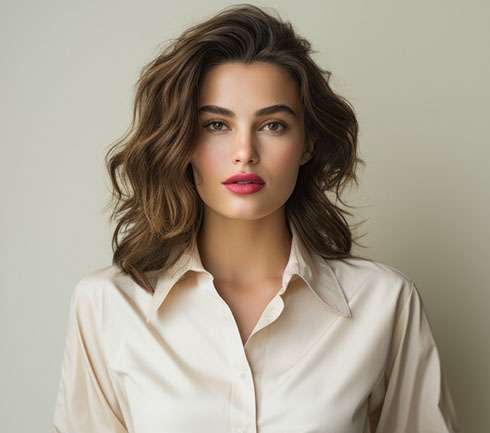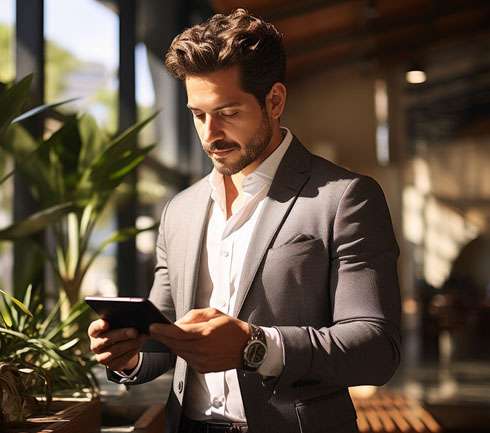It’s Tuesday, April 15, 2025 and 70°F in Austin, Texas
Anonymous Love Letters - $500
Did you know that really was a profession? In 1961 you got paid $500 per letter, that would be $4100 today! How did that work and what are some other jobs or careers that have disappeared?
 First, I should caution the reader that there is a lot of silliness on this page. But, I was reading an autobiography by Allegra Kent, a former dancer from the New York City Ballet in the late 50's and 60's. For various reasons - like a divorce from her famous photographer husband, Bert Stein (you will remember his infamous Marilyn Monroe pictures) she did jobs on the side to support her kids. One of the jobs she did was to write anonymous love letters and she was paid $500 each for them. I did a calculation of what that would be today and - shock of shocks - that would be $4100 in 2018 per letter. I was thinking about how that might work and what other jobs of the past there were that don't exist anymore.
First, I should caution the reader that there is a lot of silliness on this page. But, I was reading an autobiography by Allegra Kent, a former dancer from the New York City Ballet in the late 50's and 60's. For various reasons - like a divorce from her famous photographer husband, Bert Stein (you will remember his infamous Marilyn Monroe pictures) she did jobs on the side to support her kids. One of the jobs she did was to write anonymous love letters and she was paid $500 each for them. I did a calculation of what that would be today and - shock of shocks - that would be $4100 in 2018 per letter. I was thinking about how that might work and what other jobs of the past there were that don't exist anymore.
I suppose you would want to order and anonymous love letter because you couldn't write one yourself, you weren't creative, you had bad grammar, couldn't spell or had no self-confidence. Maybe you wanted a love letter in a foreign language because you had met some one in Rome or Paris. Perhaps you needed an anonymous letter because you wanted to convince someone you were romantic, charming or even sexy and didn't know how to pull that off. One good thing about a letter like this, you could just change the names and use them over and over again. Were they done in long hand or typewritten - I suppose they could be done both ways. People in those days wrote letters on fancy expensive paper and there were people who were professional calligraphers.
Can you imagine a lonely person sending themselves a letter from an imaginary lover? Can you imagine having fake letters sent to you from 'celebrities' or movie stars; that you could leave around for your friends to discover?
This job sorta relates to Professional Writers of Personal Ads - many years ago most singles who wanted to connect posted ads in newspapers. There were some newspapers that were loaded with these, that people bought just for the ads. Do you remember the Berkeley Barb from the 1960's. I grew up in Seattle and I remember that magazine - you could buy it on the streets in the University District. Some of the personal ads were really cool or strange. There were so many ads that it was easy to get lost, it was hard to stand out and get attention. You had to say everything in just a few words. There was actually a service here you could get your ad written for $50 - with no guarantee of success, I am sure. I knew somebody who did this job for awhile, but stopped she burned out trying to come up with new ad ideas - and when she created a hot one everyone copied it for free. Plus she got too many bounced checks.
This made me think of some other jobs that have vanished or have evolved themselves out of existence. Here's a few that came to mind:
 Judy Garland Impersonators - There were lots of people working as Judy Garland Impersonators in the 60's and 70's. One of the most famous, Jim Bailey, was a star in the 1978 Superbowl half-time show. Jim Bailey called himself a female impersonator and was a top Las Vegas star and even dated Lucille Ball's daughter. Lucy had him on her show. For a couple of years he seemed to be everywhere. I think he brought "drag" out of the shadows for main-stream America, and legitimized it. From Grand Rapids to Biloxi anybody would could pull it off seemed to be donning a wig and false eyelashes and hitting the club circuit. Many Judy Garland Impersonators were many faceted chameleons and could do other iconic stars like Barbra Streisand, Bette Davis and Carol Channing. Remember Charles Pierce? It is more than 40 years since Judy died in 1974 at 47 and I think her star has faded. Do young people even know who she is anymore? They know Dorothy Gale from the Wizard of Oz - but don't connect her to any of her other movie roles or her music.
Judy Garland Impersonators - There were lots of people working as Judy Garland Impersonators in the 60's and 70's. One of the most famous, Jim Bailey, was a star in the 1978 Superbowl half-time show. Jim Bailey called himself a female impersonator and was a top Las Vegas star and even dated Lucille Ball's daughter. Lucy had him on her show. For a couple of years he seemed to be everywhere. I think he brought "drag" out of the shadows for main-stream America, and legitimized it. From Grand Rapids to Biloxi anybody would could pull it off seemed to be donning a wig and false eyelashes and hitting the club circuit. Many Judy Garland Impersonators were many faceted chameleons and could do other iconic stars like Barbra Streisand, Bette Davis and Carol Channing. Remember Charles Pierce? It is more than 40 years since Judy died in 1974 at 47 and I think her star has faded. Do young people even know who she is anymore? They know Dorothy Gale from the Wizard of Oz - but don't connect her to any of her other movie roles or her music.
Can you guess if the person on the left is the real Judy Garland?
 Mimes - This one is so obviously a thing of the past. I only mention it because I used to know Shields and Yarnell, the married mime team, many years ago. They used to perform in San Francisco in Union Square outside Macy's - for free in 1972. There were hundreds of people in the square all the time. It created a sensation when they showed up. I worked two blocks from Union Square and used to go see them there and take them stuff to eat. Yarnell loved danishes from the Scandia Bakery on Powell Street - she had been a professional dancer before becoming a mime. They were trying to promote their careers at the time. I remember in Union Square they had me take off my shirt and autographed my back in felt pen - a huge gigantic signature with smiley faces. Somebody filmed it while a small crowd watched. Robert thought it was a great publicity stunt to get attention and made me come back and redo the "act" 4 or 5 times. It was so much trouble to get that marker ink off. We tried doing it on white shirts but that didn't get as much attention as me taking off my shirt. I still have one of the shirts. Shields is credited with being the originator of "The Robot" moves early in his career. They were married on October 27 in Union Square - I remember because it was the day after my birthday -. They divorced and Lorene Yarnell died in 2010. Robert Shields is still around - 67 years old and remarried.
Mimes - This one is so obviously a thing of the past. I only mention it because I used to know Shields and Yarnell, the married mime team, many years ago. They used to perform in San Francisco in Union Square outside Macy's - for free in 1972. There were hundreds of people in the square all the time. It created a sensation when they showed up. I worked two blocks from Union Square and used to go see them there and take them stuff to eat. Yarnell loved danishes from the Scandia Bakery on Powell Street - she had been a professional dancer before becoming a mime. They were trying to promote their careers at the time. I remember in Union Square they had me take off my shirt and autographed my back in felt pen - a huge gigantic signature with smiley faces. Somebody filmed it while a small crowd watched. Robert thought it was a great publicity stunt to get attention and made me come back and redo the "act" 4 or 5 times. It was so much trouble to get that marker ink off. We tried doing it on white shirts but that didn't get as much attention as me taking off my shirt. I still have one of the shirts. Shields is credited with being the originator of "The Robot" moves early in his career. They were married on October 27 in Union Square - I remember because it was the day after my birthday -. They divorced and Lorene Yarnell died in 2010. Robert Shields is still around - 67 years old and remarried.
Robert was trained at the Marcel Marceau School of Mime in Paris. Mime's were hugely famous for a short time in the 1970's - they were everywhere. Shields and Yarnell had their own CBS TV show for two years - from 1977-1978. A friend of mine from Salt Lake City wanted to be a mime so, so badly. He met Robert and after talking to him decided to become a professional mime - he then went to the school in Paris that Robert did. When my friend came back to the USA the mime craze was OVER, totally dead - SO SAD FOR HIM. I know it sounds like a joke, but I remember him trying out his mime act in public. Nobody was interested. Being a mime had become a joke. He then bought a set of deer stalkers in London and tried to before professional Sherlock Holmes Impersonator.
“Mimes fell out of favor,” Shields said. “These bad mimes started popping up everywhere, and people hated them. If you don’t have the right timing and a certain magic about you, you are going to look ridiculous.”
 Uncensored, Private Film Processors - In commercial processing, the film is removed automatically or by an operator handling the film in a light proof bag from which it is fed into the processing machine. The processing machinery is generally run on a continuous basis with films spliced together in a continuous line. All the processing steps are carried out within a single machine with automatically controlled time, temperature and solution replenishment rate. Although you would think there is little human intervention or supervision people looked at your pictures. Yes, it was quality control, but they were also looking for pornographic pictures. You could get arrested for nude pictures and go to prison for a long time. If you had taken pictures of sex acts you were even in more trouble. It seems to me that the film processors also functioned as morals monitors and delighted in turning people in.
Uncensored, Private Film Processors - In commercial processing, the film is removed automatically or by an operator handling the film in a light proof bag from which it is fed into the processing machine. The processing machinery is generally run on a continuous basis with films spliced together in a continuous line. All the processing steps are carried out within a single machine with automatically controlled time, temperature and solution replenishment rate. Although you would think there is little human intervention or supervision people looked at your pictures. Yes, it was quality control, but they were also looking for pornographic pictures. You could get arrested for nude pictures and go to prison for a long time. If you had taken pictures of sex acts you were even in more trouble. It seems to me that the film processors also functioned as morals monitors and delighted in turning people in.
There were people who processed film privately. They advertised in newspapers and in camera stores; they charged a lot of money and people paid. They were also sources of x-rated pictures and films. I suppose they worked like drug pushers and were referred to new clients by others. These guys learned your sexual tastes and would offer films and pictures that matched them. I asked someone who said that he thought 10% of all film processed in the USA was sent through Uncensored Private Film Processors. They could be small home operators or big companies with 30 or more employees. The bigger the city the more operators there were.
Then Polaroid introduced the Model 95. Model 95 used a secret chemical process to develop film inside the camera in less than a minute. This new camera was fairly expensive but the novelty of instant images caught the public's attention, especially for home-made pornography. By the mid-1960s, Polaroid had many models on the market and the price had dropped so that even more people could afford it. Almost overnight Uncensored Film Processors were out of business.
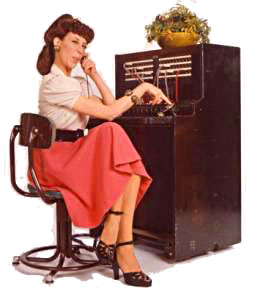 Switchboard operator - remember Lilly Tomlin and her character Ernestine? Where they really like that? The days of switchboard operators was pretty much before my time but I remember when you had to order an overseas call and have the operator call you when you were connected. Person to person calls, station-to-station. When we got our first telephone it was a multi-party line and a bunch of people shared it, like that Doris Day Rock Hudson movie, Pillow Talk. All that's gone. When I was 8 one thing that I thought was really cool was you make long distance calls to foreign countries and have your own online translator - hired from the phone company. I used it to try and call Nikita Khrushchev, the Russian Premier in the Moscow Kremlin. I wanted to talk to him about Russian palaces. We got through to someone. The line went dead, I don't know why.
Switchboard operator - remember Lilly Tomlin and her character Ernestine? Where they really like that? The days of switchboard operators was pretty much before my time but I remember when you had to order an overseas call and have the operator call you when you were connected. Person to person calls, station-to-station. When we got our first telephone it was a multi-party line and a bunch of people shared it, like that Doris Day Rock Hudson movie, Pillow Talk. All that's gone. When I was 8 one thing that I thought was really cool was you make long distance calls to foreign countries and have your own online translator - hired from the phone company. I used it to try and call Nikita Khrushchev, the Russian Premier in the Moscow Kremlin. I wanted to talk to him about Russian palaces. We got through to someone. The line went dead, I don't know why.
 Milkmen and those guys who drove bread around on trucks - I remember when I was a kid that we really had milk in glass bottles - chocolate milk - delivered to the front door. I grew up north of Seattle and it was cold enough to last outside for a while. I can't explain it, but finding that milk outside the door every morning was one of the highlights of my day when I was 5 years old. It was a miracle. Our delivery guy brought us eggs, too. Guys used to drive around my town in trucks with bakery goods - the bread was Sunbeam or Wonder Bread, everything else was really sweet and covered in sugary flavors, man that stuff must have been bad for you. I remember those chocolate covered donuts - in those days it must have been real chocolate. They also offered donuts white-dusted with powdered sugar and another version of these injected with red jam. Maple Bars - yumm. The trucks had big Sunbeam Bread logos on them. You could smell them when they got close to your house. They must have some sort of bakery-smell auto-emit device installed in them. The back doors would open and the delivery guy would pull out big trays full of goodies. You picked what you wanted, paid for it and they put it in white bags. I used to think that the delivery guy, who always wore a uniform and a cap, baked the stuff himself.
Milkmen and those guys who drove bread around on trucks - I remember when I was a kid that we really had milk in glass bottles - chocolate milk - delivered to the front door. I grew up north of Seattle and it was cold enough to last outside for a while. I can't explain it, but finding that milk outside the door every morning was one of the highlights of my day when I was 5 years old. It was a miracle. Our delivery guy brought us eggs, too. Guys used to drive around my town in trucks with bakery goods - the bread was Sunbeam or Wonder Bread, everything else was really sweet and covered in sugary flavors, man that stuff must have been bad for you. I remember those chocolate covered donuts - in those days it must have been real chocolate. They also offered donuts white-dusted with powdered sugar and another version of these injected with red jam. Maple Bars - yumm. The trucks had big Sunbeam Bread logos on them. You could smell them when they got close to your house. They must have some sort of bakery-smell auto-emit device installed in them. The back doors would open and the delivery guy would pull out big trays full of goodies. You picked what you wanted, paid for it and they put it in white bags. I used to think that the delivery guy, who always wore a uniform and a cap, baked the stuff himself.
Now it seems we should have been just as afraid of those sugar bombs in bakery goods and kids cereals as we were of Cuban missiles in the 60s.
Can you imagine? 30 years from now will people be posting nostalgic stories about Amazon deliveries and Uber drivers?
 Hippie Fashion and Lifestyle Consultants - the Summer of Love was a social phenomenon that occurred during the summer of 1967, when as many as 100,000 people, mostly young people sporting hippie fashions of dress and behavior, converged in San Francisco's neighborhood of Haight-Ashbury.
Hippie Fashion and Lifestyle Consultants - the Summer of Love was a social phenomenon that occurred during the summer of 1967, when as many as 100,000 people, mostly young people sporting hippie fashions of dress and behavior, converged in San Francisco's neighborhood of Haight-Ashbury.
Although hippies also gathered in many other places in the U.S., Canada and Europe, San Francisco was at that time the most publicized location for hippie subculture. The gathering of approximately 30,000 at the Human Be-In helped publicize hippie fashions. The Summer of Love attracted a wide range of people of various ages: teenagers and college students drawn by their peers and the allure of joining an alleged cultural utopia; middle-class vacationers; and even the wives and kids of the rich and famous. If you went to San Francisco to be cool you had to look and act the part. The establishment was mystified by and frightened of the new fashions, which were ridiculed by the tabloid press.
Getting it right was important - you couldn't show up on Haight Street and not like the a real hippie. In Beverly Hills and Palm Springs you might hire a Hippie Fashion and Lifestyle Consultant to teach you the jargon and pick out you wardrobe - finding granny glasses and matching leather fringed vests was a valuable talent. Alas, this job was "gone with the wind" by 1970 when we were no longer California dreaming....
Someone who read this blog from Beverly Hills told me that the job of Hippie Fashion and Lifestyle Consultants was also a cover for pot dealers.
I was 14 in 1967 and made a lot of money - at least it seemed like a lot at the time - designing and printing psychedelic posters for rock concerts and dance clubs in Seattle. I did my own silk-screening, too. I also did album covers. After a publisher in California saw my work, I was offered a job doing illustrations like these down there. Since I was only a teenager I had to turn the job down, but I did some freelance work for them. There were people who had the job of Psychedelic Poster Painter, so I guess I should list that one as a job that has vanished.
 Travel Agents - you had to visit a travel agent to make reservations and get airline tickets. Travel agents had to have domestic and international appointments to sell tickets and kept those decals in the window. They used to have big printed books of airline schedules and prices that came out every week. Air travel was expensive. You had to calculate fares from point to point. Interstate fares were heavily regulated and were only two choices for fares (First and Coach) until Super Saver fares came along, then there were three. Travel agents used to have machines to run through ticket stock - your itinerary and each leg was written in long-hand. In California PSA tickets were like train or bus tickets.
Travel Agents - you had to visit a travel agent to make reservations and get airline tickets. Travel agents had to have domestic and international appointments to sell tickets and kept those decals in the window. They used to have big printed books of airline schedules and prices that came out every week. Air travel was expensive. You had to calculate fares from point to point. Interstate fares were heavily regulated and were only two choices for fares (First and Coach) until Super Saver fares came along, then there were three. Travel agents used to have machines to run through ticket stock - your itinerary and each leg was written in long-hand. In California PSA tickets were like train or bus tickets.
If you wanted a deal on trips to Europe you had to book a charter airline or travel on a non-IATA airline like Icelandic - Loftleiðir, that flew to Luxembourg-Findel airport. Icelandic got the nick-name "The Hippie Express" and is fondly remembered by then college students Bill and Hillary Clinton. Many young Americans traveled to Europe after graduation, to experience the "old-world culture" and they were more concerned with getting there cheaply than comfortably or even exactly on time. They bought Air Bahama in the 60's. Sometimes when I flew on them it was on an old Air Bahama Boeing 707.
At the time, Travel Agents got discount travel by submitting a coupon from IATA at the time you booked. The number and agency had was based on its total sales. In a big travel agency there were just so many coupons available and they ran out fast. Icelandic did not require an IATA coupon to get a discount ticket so I flew that carrier a lot via Reykjavík. I think it cost me less than $100 for each trip, but they didn't have many seats available for agents, except in winter. I was in Reykjavík in winter so often it was like a second, arctic home to me. It was so beautiful to land there at night when it was snowing. I remember sitting on the tarmac there waiting to taxi to a gate. If you ever traveled via Reykjavík you will remember the Keflavik duty-free shop and all the Icelandic goodies they had there.
For most of my trips to Europe in the mid-70's my landing point after the connection in Reykjavík was Luxembourg-Findel ( I made lots of friends there as a result). From there I used Eurail Passes to travel all over the continent.
Travel agents had huge books with listings of hotels you had to sort through to find what you wanted, then you had to fax or telex them for a reservation. People were very happy to pay travel agents to make itineraries for them. Nobody did it themselves like today.
I remember travel agencies before computers were installed - everything was done by telephone - you had to call a special travel agents line at each airline. Some of these reservationists were really nice and they were well paid. In San Francisco the United Airlines reservations center was down near Fisherman's Wharf. Over the years I got to know many of the agents personally. Most of them were mowed down by AIDS in the late 1980's and early 1990's. Many of our sales reps died too. United would bring agents in to see how things worked. In those days it was a fun job, people weren't so rude and treated agents with respect. We needed them to calculate fares for us and save seats. International fares were especially hard to calculate.

Princess Diana Lifestylers and Interior Decorators - 31 years ago Princess Diana died in a Paris tunnel. In the 1980's people had careers knowing how to make Princess Diana interiors and dress. They were very popular at the time. It took a long time for them to die out. What was a Princess Diana Lifestyler? The collective hunger for all things Diana was huge in the 1980's. We wanted to be like her, to marry the prince and live happily ever after in a beautiful palace. Hers clearly was a story we like to be told over and over again, a post-modern parable about the vicissitudes of wealth, fame, beauty and idolatry — everything that goes to the true power of myth.
There were interior designers who specialized in the glam Princess Diana look. Posh English dens and flowery boudoirs with soft furniture were everywhere. Remember all the homes in slathered with Laura Ashley fabrics on the walls, beds piled high with sheets, pillows and quilts sheets and drapes? Did you know anyone who wore a knock-off of the sapphire ring and styled their hair in the same impish-elfin way she did? I did. I had a friend who had a copy of Princess Diana's Spencer Tiara that he only dared wear in private. Ralph Lauren, too, had a line for Princess Diana wannabes. It seemed like there was no limit to the effect of Princess Diana on popular culture. The Princess danced with John Travolta and brought back the choker necklace overnight. When you got married you had to have a copy of that dress - oh my dear - how hard it was to iron! No matter - it was worth it. Being a Princess Diana Lifestyler meant you were driven to grow and promote the cult of the innocent girl Elton John called "England's Rose" at her funeral.
 Do you remember - did you see - the Moldavian wedding of Prince Michael to Blake and Alexis's daughter, Amanda? This was the ultimate bleed of Dianamania into American livingrooms. Dynasty didn't stop there - later they imported English horsiness and Country Estate stables into Rock Hudson's Delta Rho Farms for a whole season. I believe, had Dynasty not ended suddenly in 1989 - and had continued to 1997 (a 17th season) - they would have found a way to weave a dead Princess into the plot.
Do you remember - did you see - the Moldavian wedding of Prince Michael to Blake and Alexis's daughter, Amanda? This was the ultimate bleed of Dianamania into American livingrooms. Dynasty didn't stop there - later they imported English horsiness and Country Estate stables into Rock Hudson's Delta Rho Farms for a whole season. I believe, had Dynasty not ended suddenly in 1989 - and had continued to 1997 (a 17th season) - they would have found a way to weave a dead Princess into the plot.
This all Diananess reached it's orgasmic crescendo when she died, millions mourned as if the world had come to an end - acres of flowers wrapped in plastic were sacrificed to ease her way into the underworld - all this and now she is almost forgotten.
And the question remains, will Princess Diana rise from the dead and summon forth her Lifestylers to recreate those chintzy boudoirs once more? Will they reappear in the pages of Architectural Digest as the latest revival in interior design styles?
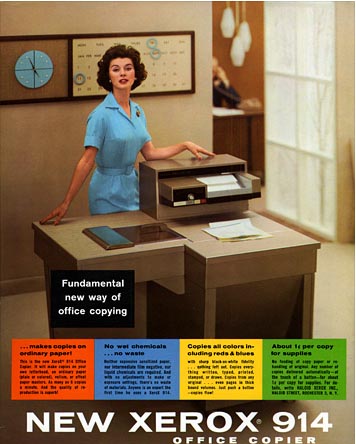 Xerox and mimeograph machines operators - before the days of home printers if you wanted more than one copy of something you had to have it xeroxed or a stencil made for a mimeograph machine that printed flyers. Knowing how to run a Xerox in the 1960's was considered a professional skill and you got paid more for it. The stencil duplicator or mimeograph machine (often abbreviated to mimeo) was a low-cost duplicating machine that works by forcing ink through a stencil onto paper. I had to run one of these when I first went to work, what a mess I made! My boss was very Germanic in her attitude towards mistakes - "alles in ordnung", everything had its proper place and had to be kept proper and tidy. The mimeo stencils I made had to be perfect - no mistakes or smudges! I needed a job very badly at the time and when they interviewed me they asked if I could type, and I said yes when I couldn't. My first day on the job they gave me envelopes to type. OMG, thank God they left me alone to do the work by myself. It was a disaster. My new co-workers were so sweet - one of them typed all the envelopes in a couple of hours - perfectly, with no mistakes - she was a professional typist. OH NO - I know you saw this coming - but the next day they doubled the number of envelopes for me to do. I felt just like Lucy on the candy making assembly line with Ethel, "Speed it up! I learned how to type in some strange chicken-like typing way - never in the right way, they way they taught it. I was really fast, but made mistakes. Do you remember typing correction whiteout? I was really good at concealing my errors and typing over them with that stuff - I can still smell it.
Xerox and mimeograph machines operators - before the days of home printers if you wanted more than one copy of something you had to have it xeroxed or a stencil made for a mimeograph machine that printed flyers. Knowing how to run a Xerox in the 1960's was considered a professional skill and you got paid more for it. The stencil duplicator or mimeograph machine (often abbreviated to mimeo) was a low-cost duplicating machine that works by forcing ink through a stencil onto paper. I had to run one of these when I first went to work, what a mess I made! My boss was very Germanic in her attitude towards mistakes - "alles in ordnung", everything had its proper place and had to be kept proper and tidy. The mimeo stencils I made had to be perfect - no mistakes or smudges! I needed a job very badly at the time and when they interviewed me they asked if I could type, and I said yes when I couldn't. My first day on the job they gave me envelopes to type. OMG, thank God they left me alone to do the work by myself. It was a disaster. My new co-workers were so sweet - one of them typed all the envelopes in a couple of hours - perfectly, with no mistakes - she was a professional typist. OH NO - I know you saw this coming - but the next day they doubled the number of envelopes for me to do. I felt just like Lucy on the candy making assembly line with Ethel, "Speed it up! I learned how to type in some strange chicken-like typing way - never in the right way, they way they taught it. I was really fast, but made mistakes. Do you remember typing correction whiteout? I was really good at concealing my errors and typing over them with that stuff - I can still smell it.
Do you ever wonder what happened to people you worked with in your distant past? Would they remember you and what would they remember about you. I have been 6'5" since I was 12. Sometimes that's all they seem to remember - that I was some blond giant. I look at pictures of myself from the past and in everyone of them I am towering over just about everybody else. At 12 they had high hopes for me as a basketball player. Unfortunately for my Jr. high school coaches I absolutely stopped getting taller at 6'5". Why I stopped growing I don't know. It's like God said that's it, Bob you are tall enough!
 TV Repairmen - these guys used to make a lot of money. My parents hated to call them. In the old days of tubed television once a TV repairman took your machine apart you never knew if they would be able to make it work again. Tubes could be hugely expensive and it seemed like the repairman always needed to take your set to his shop where who knows what he would do to it. When color came it made it even more complicated. Remember how hard it was to get your color right? When it was black and white it was easier It was a lot of fun to site and watch a TV repairman at work when I was a kid. It was space-age technology then. I remember a husband and wife team that used to work on our TV - no one believed the woman could repair a set on her own- she had to have a man with her. Remember the big chassis that you would pull out like a dishwasher bin with all the tubes attached?
TV Repairmen - these guys used to make a lot of money. My parents hated to call them. In the old days of tubed television once a TV repairman took your machine apart you never knew if they would be able to make it work again. Tubes could be hugely expensive and it seemed like the repairman always needed to take your set to his shop where who knows what he would do to it. When color came it made it even more complicated. Remember how hard it was to get your color right? When it was black and white it was easier It was a lot of fun to site and watch a TV repairman at work when I was a kid. It was space-age technology then. I remember a husband and wife team that used to work on our TV - no one believed the woman could repair a set on her own- she had to have a man with her. Remember the big chassis that you would pull out like a dishwasher bin with all the tubes attached?
I also remember we used to go to a special section in the Summers Plaza drug store in Mountlake Terrace, Washington, where they had a place to test your tubes and buy new ones. The tubes came in all different shapes and sizes and they had them for radio as well as TV.
There was a branch-occupation of TV repairman, The Hi-Fi and Stereo Repairman. They must have made a lot of money helping people do simple things like change photograph needles since I can't imagine what these guys did. BUT - The old units had tubes in them, so maybe they tested and changed them like the TV guys did. Did they help you attach speaker wire? There was a time when your stereo record player and TV came in the same box. They also had radios in them. These became quite fancy pieces of furniture - we had a Motorola French Provincial one with maplewood cabinetry in our living room, my parents were really proud of it. Where did all of those monsters go?
 Disco Dance Instructors - This was a really hot job in 1979. Everybody wanted to dance like Travolta or Deney Terrio - remember Dance Fever? He hosted that TV show from 1979 until 1985. Terrio achieved fame as the dance coach and choreographer for John Travolta in that most famous movie of the disco era Saturday Night Fever. During his heyday with Dance Fever, he even appeared in the TV show The Love Boat as a glamorous dance instructor. Disco dancing was really hard - especially if you had no rhythm. You used to be able to hire coaches who worked out of the discos themselves - training people during the day when the disco was closed. Many of these Disco Dance Instructors were actually ballroom dance instructors from places like Arthur Murray freelancing on the side. There was also a branch-off of this business teaching disco roller skating. Everybody used to roller skate in Golden Gate Park on the weekends. They closed off some of the streets in the park and thousands of people dressed in their best disco clothes and hit the asphalt it those amazing skates they used to sell. You could rent them outside the park from special stands. I was REALLY REALLY bad at Disco roller skating and caused many accidents. Can you imagine how frightening a 6'5'" tall guy like me would look - skating and slipping out of control - in the crowd. Those skates made me even taller and were potentially lethal weapons.
Disco Dance Instructors - This was a really hot job in 1979. Everybody wanted to dance like Travolta or Deney Terrio - remember Dance Fever? He hosted that TV show from 1979 until 1985. Terrio achieved fame as the dance coach and choreographer for John Travolta in that most famous movie of the disco era Saturday Night Fever. During his heyday with Dance Fever, he even appeared in the TV show The Love Boat as a glamorous dance instructor. Disco dancing was really hard - especially if you had no rhythm. You used to be able to hire coaches who worked out of the discos themselves - training people during the day when the disco was closed. Many of these Disco Dance Instructors were actually ballroom dance instructors from places like Arthur Murray freelancing on the side. There was also a branch-off of this business teaching disco roller skating. Everybody used to roller skate in Golden Gate Park on the weekends. They closed off some of the streets in the park and thousands of people dressed in their best disco clothes and hit the asphalt it those amazing skates they used to sell. You could rent them outside the park from special stands. I was REALLY REALLY bad at Disco roller skating and caused many accidents. Can you imagine how frightening a 6'5'" tall guy like me would look - skating and slipping out of control - in the crowd. Those skates made me even taller and were potentially lethal weapons.
 I took ballet in high school, at Cornish and the UW in Seattle. I was terrible at it. Cornish gave me a scholarship because they needed boys, it was also an art school and so I agreed to dance with the girls to go for free. "Pick them up and put them down - that's all you have to do" - that's what they promised when I signed the scholarship contract. They were wrong it would not be that easy.
I took ballet in high school, at Cornish and the UW in Seattle. I was terrible at it. Cornish gave me a scholarship because they needed boys, it was also an art school and so I agreed to dance with the girls to go for free. "Pick them up and put them down - that's all you have to do" - that's what they promised when I signed the scholarship contract. They were wrong it would not be that easy.
The ballet mistress at the school, Karen Irvin, hated me because she said I was freeloading on her dance department budget. She never left me alone and tried to run me out of the school. "I'm watching you, Bob!" she would shout out for everyone to hear during barre, "you are the reason we don't have new tutus this season!" I tried to convince her that I intended to go into costume and stage design to justify remaining on a ballet scholarship, but she wouldn't buy it. In the end I was allowed to stay because the artist, Chuck Close, put in a good word for me with the scholarship committee. He saw my work and concluded I was a promising artist that Cornish should support, which ever department was paying for it.
Tour en l'airs were the only thing I could do well. Tour en l'air is a ballet step done by men where you would jump up high and do turns - twirling yourself around. I was able to do three turns in the air at one time, which was pretty amazing, but since I no coordination in ballet I was incapable of putting the steps together into anything that looked graceful. My ballet classmates were amazed I could do this, so I used to show-off all the time doing them. Miss Irvin was not impressed, she used to say that even a gorilla could be trained to do the tricks I did. Obviously that was an exaggeration, but I never really did master the simple waltz, and that is saying something.
This was the disco era and I went to discos in Seattle like Shelly's Leg. I frequently would do this stunt on the dance floor to impress. It didn't always work the way I wanted, once in the air I could not be absolutely sure I would land right. The dance floors at Shelley's was small and packed full of people most of the time.
Bob Atchison

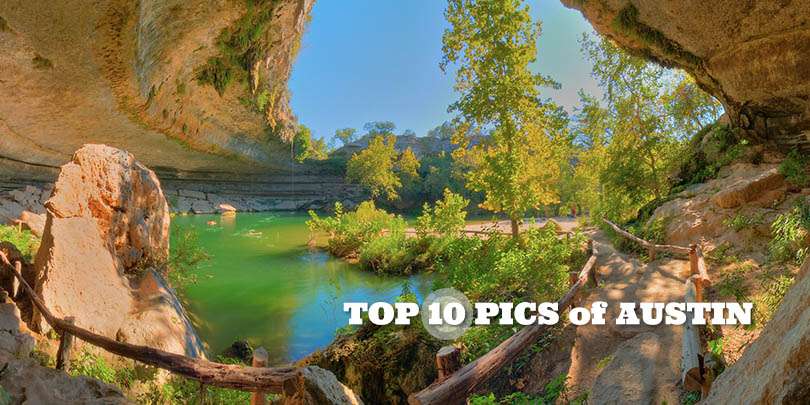















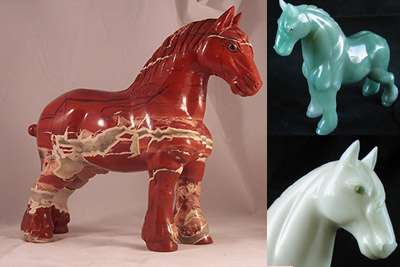

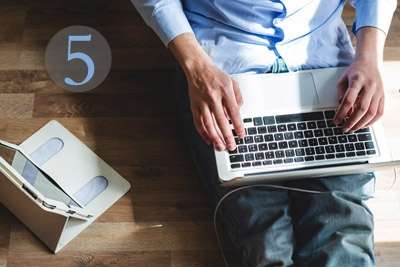









 New Home Builder Website Checklist
New Home Builder Website Checklist 

